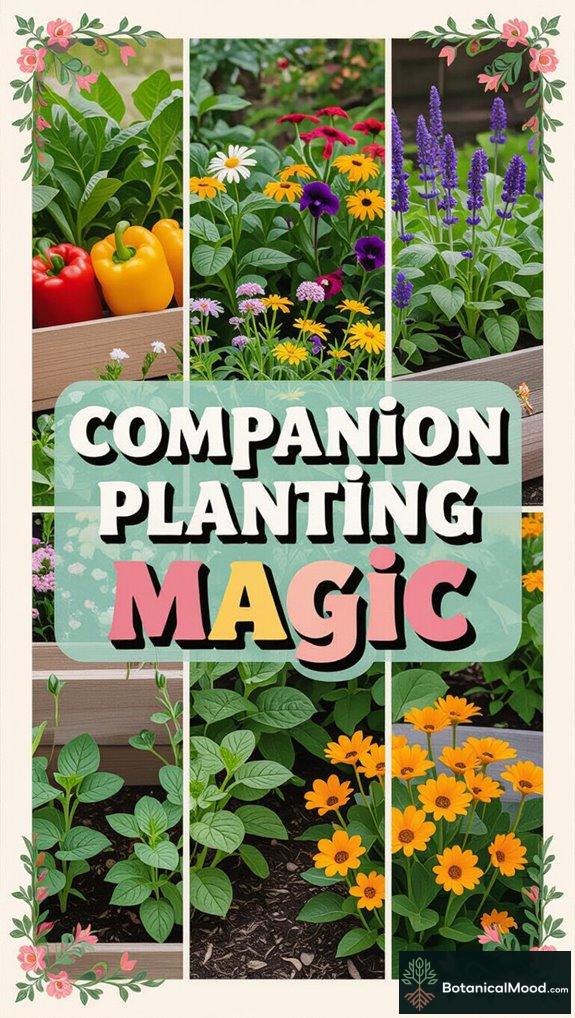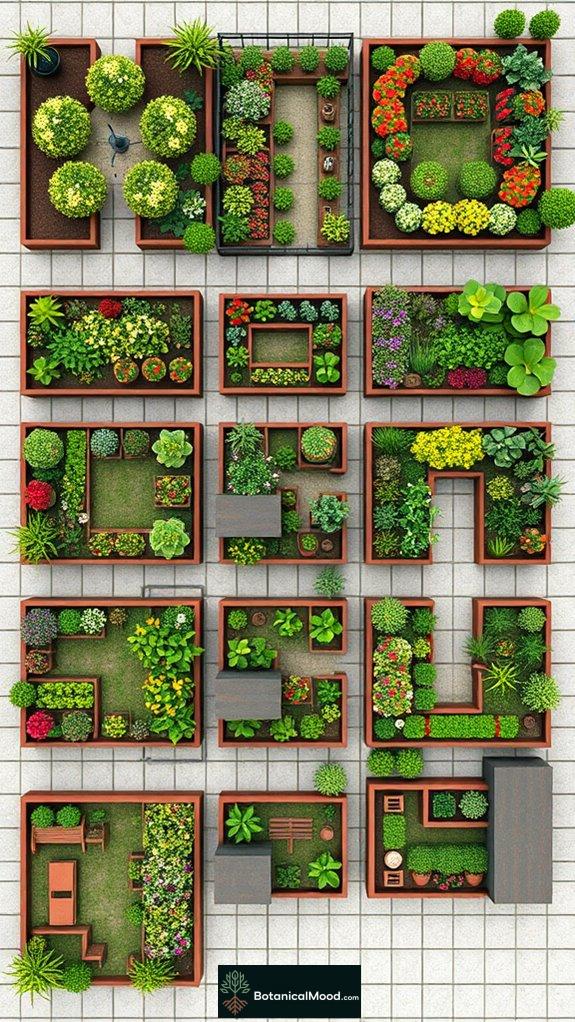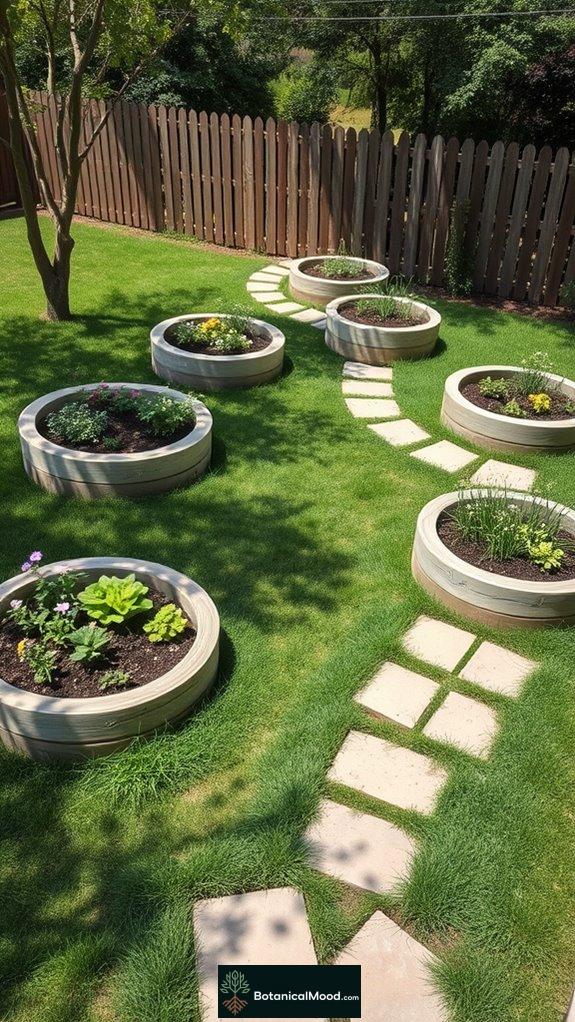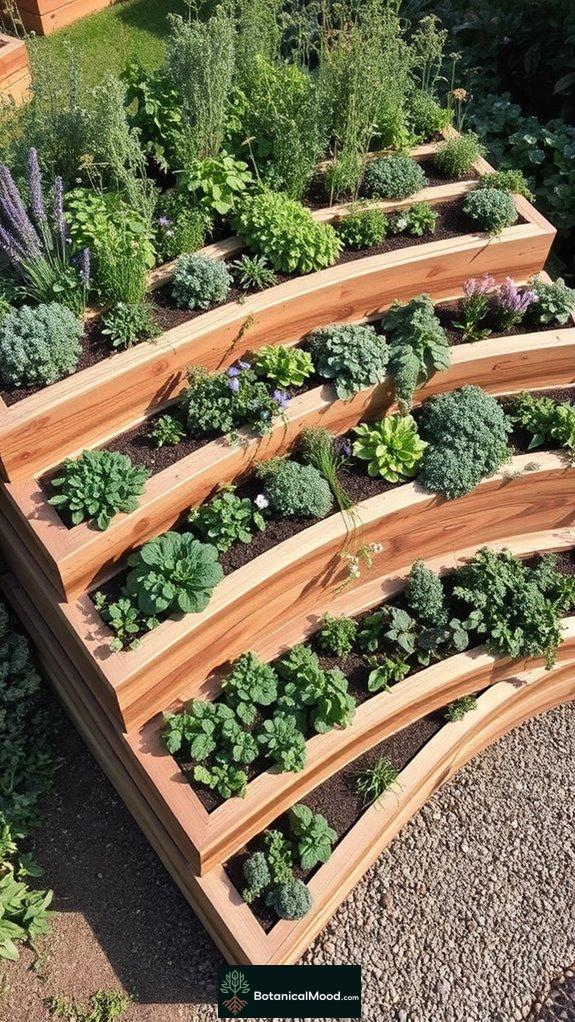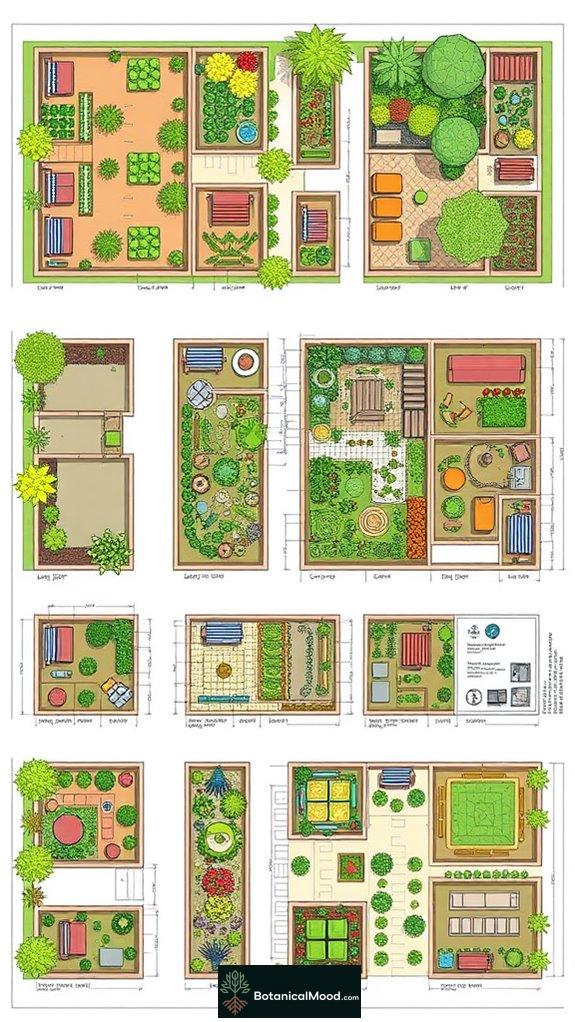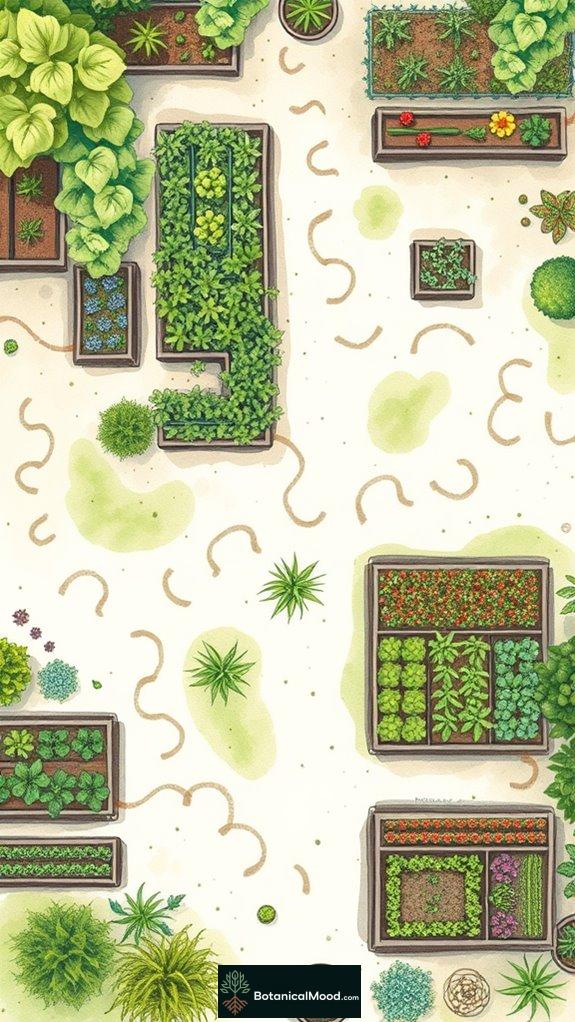Companion planting is basically gardening’s secret sauce!
I’ve learned it can skyrocket my raised bed yields. Imagine pairing deep-rooted beets with lofty kale—it’s like stacking chairs to get everyone at the dinner table.
I even intercropped some fancy herbs with my veggies. Who knew that attracting beneficial bugs could be so magnetic?
The best part? My top-notch tools make it all a breeze, nurturing my soil like a spa day.
Have I mastered it all? Not quite. But that’s what makes this green thumb journey so rewarding!
Designing Your Garden: A Personal Tale of Success
Reflecting on my first garden design, I was like a kid in a candy store. I crammed broccoli, tomatoes, and even marigolds into my raised bed. Spoiler alert: it was a jungle!
Later, I learned spatial harmony can make or break your harvest. Using companion planting principles, I revamped my layout for maximum sunlight and airflow. The result? A flourishing, productive garden filled with vibrant colors and scents.
So, whether you’re coaxing out the bees or keeping pests at bay, thoughtful design can nurture health and biodiversity right in your backyard.
Quick Takeaways
- Pair deep-rooted plants with shallow-rooted varieties to utilize nutrient layers effectively and optimize space in raised beds.
- Incorporate companion plants like marigolds to attract beneficial insects, enhancing pest control and supporting healthier crops.
- Use vertical growth techniques in raised beds to maximize sunlight and air circulation, significantly improving plant yield and aesthetics.
- Rotate crops seasonally for continuous harvests, adjusting plant pairings to optimize nutrient use and reduce pest issues.
- Select compatible plant combinations, promoting biodiversity to confuse pests and enrich soil health through natural nutrient cycling.
Maximizing Vertical Space in Raised Beds

When it comes to maximizing vertical space in raised beds, I’ve found that employing a tiered approach can truly elevate both the aesthetic and productivity of my garden.
Utilizing vertical growth techniques, like trellises and vertical planters, allows me to cultivate a diverse array of plants, from vining cucumbers to cascading flowers.
Employing trellises and vertical planters transforms my garden into a lush tapestry of vining cucumbers and cascading blooms.
Implementing strategic space optimization strategies enables me to create layers, enhancing air circulation while maximizing sunlight exposure.
Integrating color coordination within these tiers not only beautifies my garden but also attracts beneficial pollinators.
This holistic approach guarantees my garden thrives and showcases the enchanting potential of vertical gardening.
In fact, vertical gardening can significantly increase your plant yield by allowing for efficient use of limited ground space.
Intercropping for Pest Control

Is there a more effective way to protect your garden from pests than by intercropping?
By carefully selecting plant pairings based on intercrop timing, I’ve enhanced my garden’s resilience. For example, planting marigolds among vegetables attracts beneficial insects like ladybugs and lacewings, while deterring common pests. Additionally, incorporating biodiversity in planting can further optimize pest control and improve soil health.
As I vary planting schedules, I create layers of biodiversity that confuse and repel unwanted critters. This practice not only protects my crops but also elevates the overall health of my soil and ecosystem.
If you’re looking to exert greater control, consider this powerful technique and watch your garden flourish beautifully and effectively.
Layering Root Depths for Nutrient Efficiency

While cultivating a diverse garden is essential for resilience, layering root depths can considerably enhance nutrient efficiency, optimizing the way plants access essential minerals and water.
Strategically placing deep-rooted plants alongside shallow-rooted ones minimizes root competition while maximizing the utilization of various nutrient zones.
For instance, pairing carrots with radishes allows carrots to explore deep into the soil, while radishes tap into the upper layers. This thoughtful arrangement not only conserves water but also guarantees that nutrients like nitrogen, phosphorus, and potassium are effectively scavenged, creating a thriving ecosystem that I find utterly gratifying in my own raised bed garden. Additionally, incorporating ornamental plants can attract beneficial pollinators and enhance overall biodiversity in the garden.
Seasonal Planting for Continuous Harvest

To guarantee a steady supply of fresh produce throughout the growing season, I’ve embraced the practice of seasonal planting, which not only stretches the garden’s bounty but also adds a dynamic visual element to the scenery.
Implementing season extension techniques, like using cold frames and row covers, allows me to sow crops earlier and harvest later.
Combining Aromatic Herbs With Vegetables
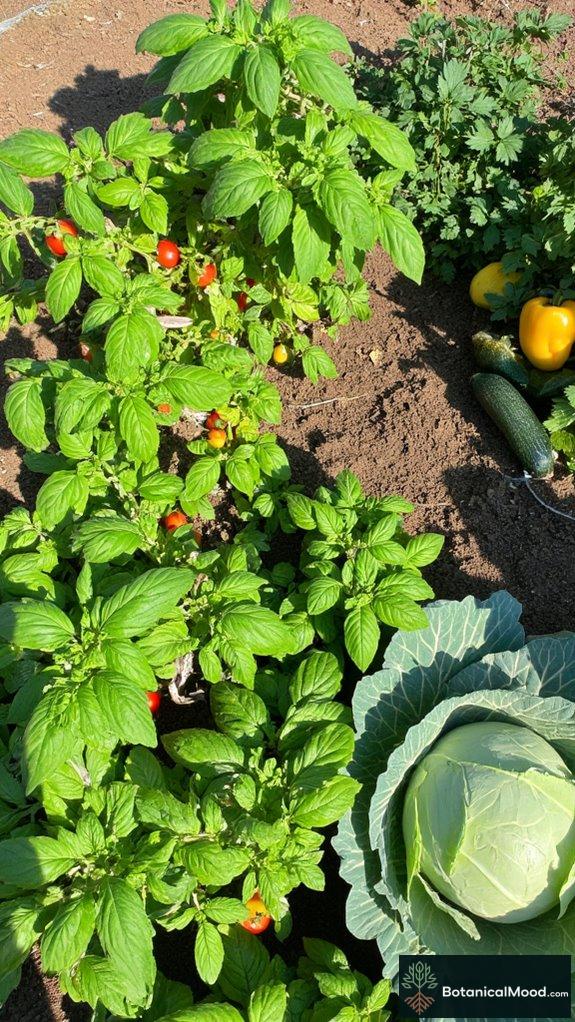
Incorporating aromatic herbs into vegetable gardens not only maximizes space but also enhances the overall health and aesthetic of the garden, creating a harmonious environment that benefits both the plants and the gardener. By selecting your herb preferences wisely, you’ll enjoy various aromatic benefits while improving yields.
Here are some powerful pairings to evaluate:
- Basil with tomatoes: encourages flavor development
- Cilantro alongside peppers: boosts growth and flavor
- Oregano near zucchini: promotes vigor in both plants
- Mint with cabbage: deters pests naturally
- Dill interspersed with onions: enhances growth rates
These combinations transform your garden into a thriving, beautiful ecosystem, just as incorporating native plants can support essential pollinators.
Utilizing Trap Crops to Deter Pests

Trap crops can substantially enhance garden pest management, providing a proactive solution that many seasoned gardeners swear by. By planting certain crops, like radishes or mustard, specifically designed to attract pests, I create a diversion, drawing harmful insects away from my precious vegetables.
These trap crops thrive and entice pests, such as aphids or cabbage worms, allowing me to manage their populations effectively. Regularly monitoring these areas guarantees I can intervene promptly, implementing organic pest control methods when needed.
Utilizing trap crops not only protects my yields but also transforms the garden into a harmonious ecosystem, enhancing both beauty and function.
Designing for Pollinator Attraction and Biodiversity
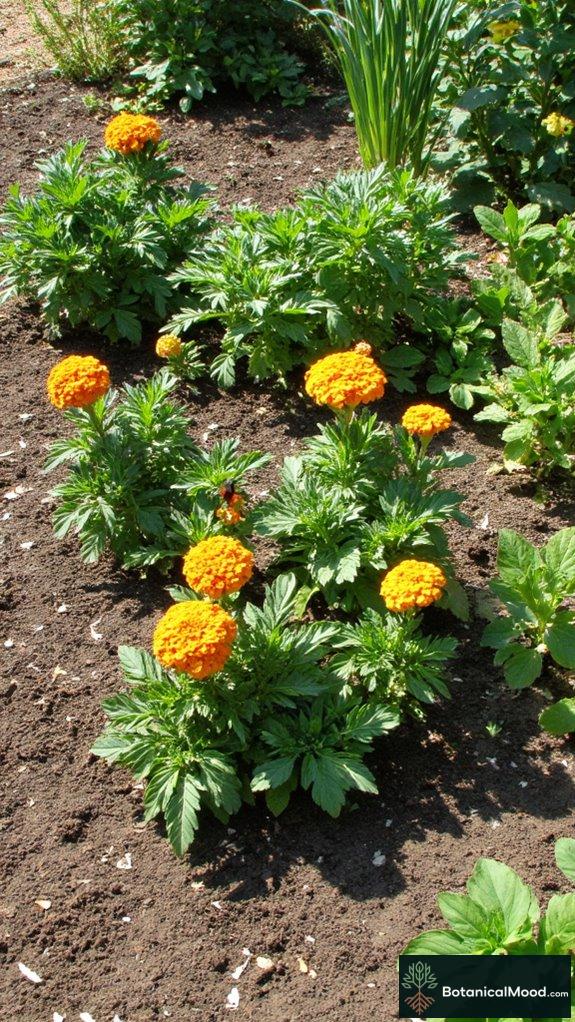
Creating a garden that actively attracts pollinators while promoting biodiversity involves a thoughtful design that harmonizes color, texture, and fragrance.
Case Study: Layout Inspirations

Layout inspirations for companion planting can transform a garden space into a vibrant symphony of color, texture, and functionality, enhancing both aesthetics and productivity. Creating plant guilds with arrangements like the “Three Sisters”—squash, beans, and corn—offers visual appeal and mutual benefits, while flowers like marigolds and chives enhance plant aesthetics and repel pests. Companion planting promotes biodiversity by mimicking natural ecosystems, adding another layer of richness to the garden’s design. Utilizing vertical space with trellises supports climbing plants, freeing precious ground for lower varieties. Mixing colors and textures not only beautifies but also promotes biodiversity, ensuring a thriving environment. In my journey with Botanical Mood, I’ve found intentional design can elevate both harvests and enjoyment from our gardening spaces.
Companion Plant Arrangement Techniques

Companion planting techniques are key to maximizing the overall productivity and health of a garden. By understanding root compatibility and growth habits, I can create a harmonious ecosystem that enhances yield and minimizes pests.
Companion planting fosters a thriving garden ecosystem, improving productivity and pest management through thoughtful plant pairings.
Here are some effective arrangements I’ve found useful:
- Pair deep-rooted plants like beets with shallow ones such as kale.
- Combine vining crops like corn with sprawling squash.
- Utilize multi-layer planting to cultivate diverse growth habits.
- Intercrop root veggies with leafy greens for nutrient balance.
- Guarantee adequate spacing to prevent overcrowding and competition.
Meet the Garden Enthusiast
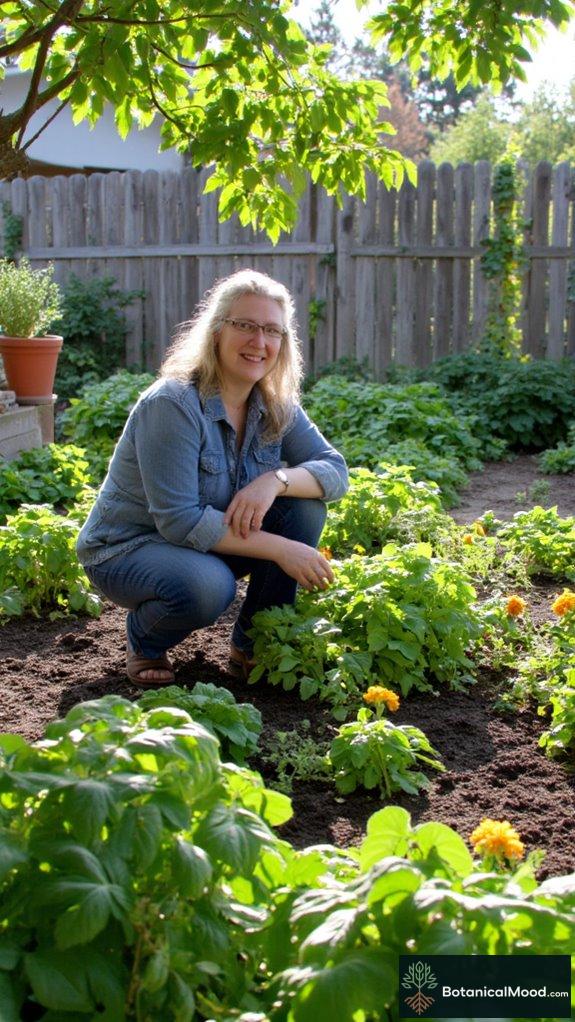
Meet the Garden Enthusiast, Emily Johnson from Portland, Oregon. Her passion for gardening blossomed during childhood, inspired by her grandmother’s vibrant vegetable patch that ignited a lifelong dream to cultivate her own garden sanctuary.
Emily achieved her dream garden design through meticulous planning and research. She harmonized colors, textures, and plant varieties, utilizing resources like “The Garden Design Book” and online tools from companies like Garden Planner to visualize layouts and guarantee ideal companion planting.
To bring her vision to life, Emily used high-quality tools from brands like Fiskars and The Garden Tool Company, enhancing her efficiency.
She collaborated with local horticulturists, such as those at Portland Nursery, to select plants that would thrive in her garden’s unique environment.
Top Vegetable Varieties for Gardens

When you think of the best vegetable varieties for your garden, it’s essential to take into account not only the aesthetics but also the functionality and productivity of your chosen plants.
| Vegetable | Characteristics |
|---|---|
| Heirloom Tomatoes | Exceptional flavor, good yields |
| Carrots | Deep roots, ideal for raised beds |
| Spinach | Fast-growing, nutrient cycling |
| Bush Beans | Compact, enrich soil nitrogen |
| Zucchini | High yield, thrives in warm soil |
Opt for heirloom varieties for unique flavors while emphasizing nutrient cycling to enhance soil health. These selections promote both beauty and productivity, ensuring a bountiful harvest.
Summary
Incorporating companion planting into your raised bed garden not only enhances yields but also nurtures nature’s balance, creating a vibrant ecosystem. With thoughtful techniques, like intercropping and aromatic herb combinations, you can cultivate a luscious scenery brimming with botanical beauty. As you explore diverse plant pairings, you’ll find your culinary creations enriched by fresh flavors from your garden. Embrace these strategies, and you’ll transform your plot into a productive paradise, fostering both growth and gratitude for the earth’s gifts.
References
- https://learn.eartheasy.com/guides/companion-planting-for-raised-garden-beds/
- https://www.rainbird.com/homeowners/blog/the-benefits-of-companion-planting
- https://kellogggarden.com/blog/gardening/benefits-of-companion-planting/
- https://www.epicgardening.com/companion-planting-fad-or-science/
- https://kellogggarden.com/blog/the-ultimate-guide-to-raised-bed-gardening-for-every-climate/
- https://www.gardenmyths.com/companion-planting-truth-myth/
- https://www.gardeners.com/how-to-folder/planting-and-care/companion-planting
- https://www.youtube.com/watch?v=cRgzYrtzBBQ
- https://savvygardening.com/4×8-raised-bed-vegetable-garden-layout/
- https://homesteadandchill.com/benefits-companion-planting-chart/
- https://platthillnursery.com/mapping-your-raised-garden-beds-chicago/
- https://www.gardenary.com/blog/companion-planting-made-easy-steps-to-create-companion-planting-plans
- https://www.vegega.com/blogs/gardening-tips/companion-planting-form-for-your-raised-garden-bed
- https://www.youtube.com/watch?v=EwOc2I5JUwE
- https://gardensavvy.com/gardening-blog/gardening-tips/7-traits-of-successful-home-gardeners/
- https://www.youtube.com/watch?v=3q8-72bm1Os
- https://www.16personalities.com/articles/how-does-your-garden-grow-personality-type-and-gardening-style
- https://www.ycp.edu/news/what-is-a-horticulturist
- https://gardenrant.com/2023/01/call-yourself-a-gardener.html
- https://ludwig.guru/s/nature+enthusiast
- https://www.powerthesaurus.org/nature_enthusiast/definitions
- https://thehomesteadingrd.com/best-vegetables-to-grow-in-raised-beds/
- https://plantperfect.com/vegetables-that-grow-best-in-a-raised-garden-bed/
- https://savvygardening.com/best-vegetables-to-grow-in-raised-beds/
- https://food52.com/story/27387-best-vegetables-to-grow-in-raised-beds
- https://www.youtube.com/watch?v=WaV8EKuCE8E
- https://frameitall.com/blogs/frame-it-all/high-yield-vegetables
- https://www.gardenary.com/blog/what-to-plant-in-a-raised-garden-bed
- https://growwhereyousow.com/best-vegetables-plant-raised-garden-beds/
